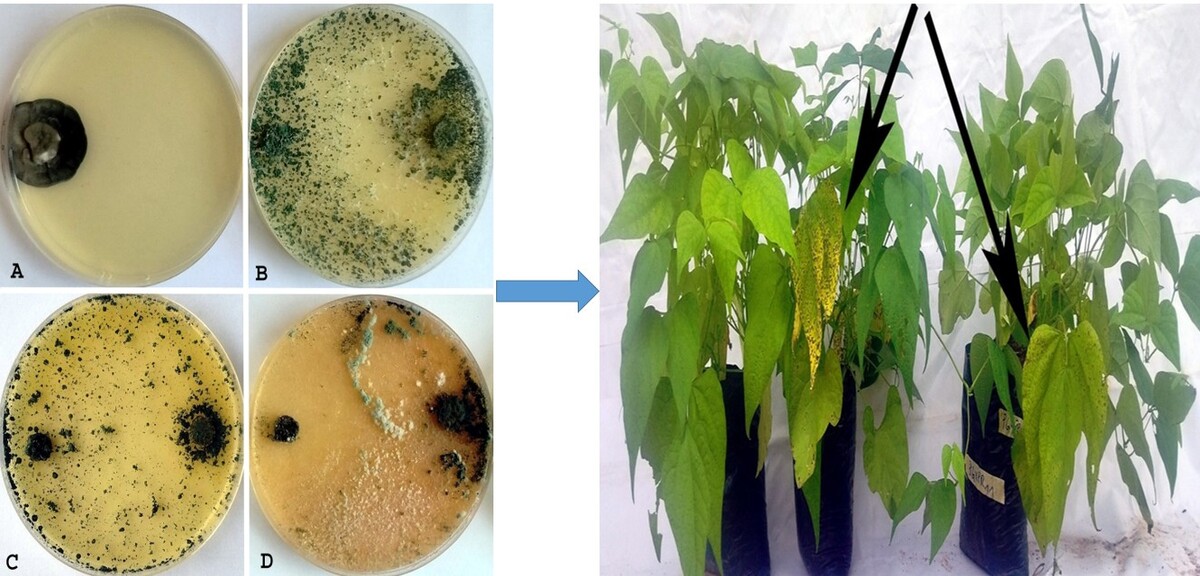ORIGINAL ARTICLE
Biological control potential of Trichoderma asperellum against Pseudocercospora griseola, the etiological agent of angular leaf spot in Common bean (Phaseolus vulgaris L.)
1
Crop Protection, Institute of Agricultural Research for Development (IRAD), Nkolbisson, P.O. Box 2067, Yaoundé, Cameroon
2
Antimicrobial & Biocontrol Agents Unit (AmBcAU), Laboratory for Phytobiochemistry and Medicinal
Plants Studies, Department of Biochemistry, Faculty of Science, University of Yaoundé 1, Messa, P.O. Box 812, Yaoundé, Cameroon
3
Post-Harvest Unit, Ekona Agricultural Research Centre, Institute of Agricultural Research for Development (IRAD), Ekona, P.O. Box 25, Buea, Cameroon
4
Antimicrobial & Biocontrol Agents Unit (AmBcAU), Laboratory for Phytobiochemistry and Medicinal Plants Studies, Department of Biochemistry, Faculty of Science, University of Yaoundé 1, Messa, P.O. Box 812, Yaoundé, Cameroon
5
Department of Agriculture, University of Dschang, P.O. Box 96, P.O. Box 96, Dschang, Cameroon
6
Annual Crop, International Institute for Tropical Agriculture (IITA), Goma, P.O. Box 4163, Kinshasa, Congo
A - Research concept and design; B - Collection and/or assembly of data; C - Data analysis and interpretation; D - Writing the article; E - Critical revision of the article; F - Final approval of article
Submission date: 2025-07-16
Acceptance date: 2025-09-23
Online publication date: 2025-10-29
Corresponding author
Gael Chatue Chatue
Crop Protection, Institute of Agricultural Research for Development (IRAD), Nkolbisson, P.O. Box 2067, Yaoundé, Cameroon
Crop Protection, Institute of Agricultural Research for Development (IRAD), Nkolbisson, P.O. Box 2067, Yaoundé, Cameroon
HIGHLIGHTS
- T. asperellum PR11, PR12, and 659-7 completely inhibited the growth of P. griseola
- T. asperellum PR11 protects bean leaves from angular leaf spot disease
- Protection of bean was associated with an increase in total phenols and flavonoids
KEYWORDS
TOPICS
ABSTRACT
Angular leaf spot disease, which is caused by the fungus Pseudocercospora griseola, is among the most damaging diseases affecting common bean (Phaseolus vulgaris L.), impacting both yield and grain quality. Because of the environmental risks associated with fungicides and the variability in the virulence of P. griseola isolates, biological control emerges as a promising alternative for managing this disease. This study assessed the biological control potential of Trichoderma asperellum 659-7, PR11, and PR12 against P. griseola. Additionally, changes in some biochemical parameters were also investigated. The findings revealed that the three tested strains stopped the growth of P. griseola during the confrontation test, achieving 100% inhibition. Furthermore, the cell-free culture filtrates from each T. asperellum strain hindered the mycelial growth and spore germination of P. griseola, with the level of inhibition depending on both the concentration of culture filtrate and the specific strain of T. asperellum. The most significant reduction was noted with T. asperellum PR11, which decreased mycelial growth by 26.33% and spore germination by 27.14% at 25% (v/v). Moreover, treating infected bean leaves with T. asperellum PR11 led to a reduction in disease severity by 11.32 and 22.5% at 14 and 21 days after inoculation, respectively. An increase in chlorophyll content (287.087%), total phenols (43.116%), and flavonoids (72.010%) was also observed when infected leaves were treated with T. asperellum PR11. These overall results endorse the effectiveness of Trichoderma asperellum PR11 as a biological control agent for managing bean angular leaf spot, offering an alternative and environmentally friendly strategy.
CONFLICT OF INTEREST
The authors have declared that no conflict of interests exist.
Share
RELATED ARTICLE
We process personal data collected when visiting the website. The function of obtaining information about users and their behavior is carried out by voluntarily entered information in forms and saving cookies in end devices. Data, including cookies, are used to provide services, improve the user experience and to analyze the traffic in accordance with the Privacy policy. Data are also collected and processed by Google Analytics tool (more).
You can change cookies settings in your browser. Restricted use of cookies in the browser configuration may affect some functionalities of the website.
You can change cookies settings in your browser. Restricted use of cookies in the browser configuration may affect some functionalities of the website.




